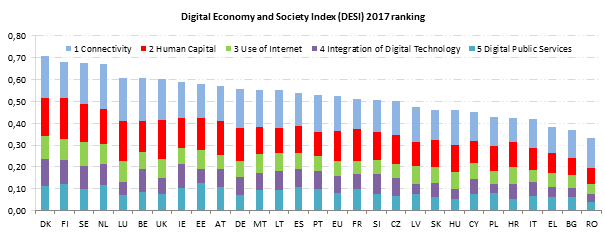
The Digital Economy and Society Index (DESI) is a composite index that summarises relevant indicators on Europe’s digital performance and tracks the evolution of EU member states in digital competitiveness.
Denmark, Finland, Sweden and the Netherlands have the most advanced digital economies in the EU followed by Luxembourg, Belgium, the UK and Ireland. Romania, Bulgaria, Greece and Italy have the lowest scores on the DESI.
In 2016, all Member States improved on the DESI. Slovakia and Slovenia progressed the most (more than 0.04 as opposed to an EU average of 0.028). On the other hand, there was low increase in Portugal, Latvia and Germany (below 0.02).
DESI scores by dimension
1. Connectivity
The Connectivity dimension measures the deployment of broadband infrastructure and its quality. Access to fast broadband-enabled services is a necessary condition for competitiveness.
On Connectivity, the highest score in 2016 was registered by the Netherlands followed by Luxembourg and Belgium. Croatia, Bulgaria and Poland had the weakest performance regarding broadband infrastructure and take-up.
Fixed broadband is available to 98% of Europeans, and 76% of European homes can access high-speed broadband (at least 30 Mbps).
4G mobile networks cover on average 84% of the EU's population (measured as the average of each mobile telecom operator's coverage within each country). 74% of European homes subscribe to fixed broadband, and over one third of these connections are high-speed. The number of high-speed connections went up by 74% in two years.
2. Human Capital/Digital skills
The Human Capital dimension measures the skills needed to take advantage of the possibilities offered by a digital society. Such skills go from basic user skills that enable individuals to interact online and consume digital goods and services, to advanced skills that empower the workforce to take advantage of technology for enhanced productivity and economic growth.
In the Human Capital dimension, Denmark, Luxembourg Finland, Sweden and the Netherlands obtained the highest scores in 2016, and Romania, Bulgaria, Greece and Italy got the lowest ones.
79% of Europeans go online regularly (at least once per week), up by 3 percentage points compared with last year.
44% of Europeans still do not have basic digital skills.
The EU improved slightly in the number of Science, Technology, Engineering and Mathematics (STEM) graduates (19 graduates per 1000 people aged 20 to 29 years old in 2014, compared to 17 in 2012) and in the share of ICT specialists in the workforce (3.6 % in 2015 as opposed to 3.2 % in 2013).
3. Use of Internet by citizens
The Use of Internet dimension accounts for the variety of activities performed by citizens already online. Such activities range from consumption of online content (videos, music, games, etc.) to modern communication activities or online shopping and banking.
Regarding the Use of Internet in 2016, internet users are the most active in Denmark, Sweden, Luxembourg and the Netherlands. On this dimension, Romania, Bulgaria and Italy are at the bottom of the list.
The percentage of internet users that engage in various online activities, such as reading news online (70%), using the internet to perform video or audio calls (39%), using social networks (63%), shopping online (66%) or using online banking (59%) increased slightly over the last couple of years.
4. Integration of Digital Technology by businesses
The Integration of Digital Technology dimension measures the digitisation of businesses and their exploitation of the online sales channel. By adopting digital technology businesses can enhance efficiency, reduce costs and better engage customers, collaborators and business partners. Furthermore, the Internet as a sales outlet offers access to wider markets and potential for growth.
As for the Integration of technology in 2016, businesses are the most advanced in Denmark, Ireland and Finland, and the least developed in Romania, Poland and Bulgaria.
European businesses are increasingly adopting digital technologies, such as the use of a business software for electronic information sharing (from 26% in 2013 to 36% of enterprises in 2015), sending electronic invoices (from 11% in 2014 to 18% of enterprises in 2016) or using social media to engage with customers and partners (from 14% in 2013 to 20% of enterprises in 2016).
eCommerce by SMEs also grew slightly (from 15% in 2014 to 17% of SMEs in 2016). Nevertheless, less than half of these companies sell to another EU Member State.
5. Digital Public Services
The Digital Public Services dimension measures the digitisation of public services, focusing on eGovernment. Modernisation and digitisation of public services can lead to efficiency gains for the public administration, citizens and businesses alike as well as to the delivery of better services for the citizen.
European champions in Digital Public Services in 2016 are Estonia, Finland and the Netherlands, while Romania, Hungary and Croatia are lagging behind
The quality of European online public services slightly improved with an increase in the number of public services available online (online service completion score increased from 75 in 2014 to 82 in 2016). At the same time, the score measuring the reuse of user data already known to the public administration as a way of facilitating the delivery of online services remained stable.
As for the demand side, 34 % of internet users returned filled forms online to the public administration (i.e. have used online public services for more than just obtaining information), up from 27% three years ago.
Team responsible: DG CONNECT